Summary and abstracts of issue n° 110
Philippe Mesnard: Editorial: Demande de fable, exigence de vérité [Asking for fables, demanding the truth] (pdf in French) (pdf in Dutch)
Dossier: Displacement, deportation, exile
Philippe Mesnard (Auschwitz Foundation, Blaise-Pascal University – Clermont-Ferrand 2): Problématisation générale (pdf in French) [The general problem]
I. Displacement and deportation
Annette Becker (Paris West University – Nanterre, Institut Universitaire de France) : Les déplacements de population pendant la Grande Guerre : exodes, refuges, camps, travail forcé (pdf) [Population displacements during the First World War: exodus, refuges, camps, forced labor]
- Consciously or not, the Great War has been a laboratory for the 20th century. It was a field where violence could be experimented, a place to put it in practice and optimize its effects on men and equipment. The invasion and military occupation zones in particular gave the opportunity to test in life size the displacements, repressions or even the extermination policies concerning the Armenians living in the Ottoman Empire.
Etymologically the latin word “exterminare” means “to expel, to send across the borders”. For the civilians who were invaded and occupied between 1914 and 1918 “being exterminated” would imply this way of being literarly knocked out of the front line while they are actually included in it. To run away, to look for shelter, but forced by invasion is active; to be expelled, deported forced as a hostage, or for forced labor is passive; in every instance it means being torn from the place you live in and brought to a place of exile which is temporary, i.e. the time the war lasts. But this generally means four years. We will attempt a (too) general typology of the displacements of the numerous populations that concerned millions of civilians throughout Europe.
Janine Altounian (writer and translator) : Lecture et refoulement d’un Journal de déportation (pdf) [Review and suppression of a diary of the Armenian deportation]
- A personal experience will tend to show how the psychic position of someone varies when readinga deportation Journal reporting events that were undergone during the Armrnian genocide in 1915; how reading this modifies his relationship with truth and reveals to him how he repressed theimpact of too personal facts of his intimate history although he had known them for a long time.
II. Exile and exodus
Sandrine Marchand (University of Artois) : Taïwan, l’exil impossible (pdf) [Taiwan, the impossible exile]
- In 1945, after 50 years of Japanese colonisation (1895-1945) Taiwan is given back to the leader of the Chinese national party Chiang Kai-shek who will be pushed out of China with his army and his government by Mao’s communist forces during the Civil War which ended in 1949. The Continentals, as they were called by the native born population, will live in an exile that was supposed to be temporary but that would last until today. The nationalist regime started to build up a nostalgic anti-communist discourse hoping to reconquer the continent where the Continentals who were separated from their country of origin and their families would get together again. As far as they are concerned, the native Taiwanese don’t recognize themselves neither in this discourse nor in that government they have diverged from since 1945 and keep living with the oppression and the memory of the massacre of the 28th February 1945 caused by the nationalist government, and which will be continued up to the beginning of the sixties, by the so called White Terror period, particularly involving left wing intellectuals. The elaborate identity situation of Taiwan has been the object of two stories based on memory, of two different constructions of History, clashing with one another, found in political discourses but also in litterary writings and testimonies.
Catherine Milkovitch-Rioux (CELIS, Blaise-Pascal University – Clermont-Ferrand 2, Institut d’Histoire du Temps Présent (IHTP) [Institute of Contemporary History] ̶ CNRS, Paris) : Enfance violence exil : Témoignages d’enfants de harkis (pdf) [Childhood, violence, exil: testimony from children of Harkis]
- As part of the reflection on “displacements, deportations, exile” initiated by the Auschwitz Foundation the object of this presentation is the testimony of the Harki's children about Harki camps in the aftermath of the Algerian War. In “De l'exode à l'exil. Rapatriés et pieds noirs en France” [From exodus to exile. Rapatriates and “pieds noirs” in France] Jean-Jacques Jordi emphasized the extent of population movements at the end of the Algerian War. The populations of the so called “French repatriated muslims” and the “pieds noirs” populations are concerned with this “exodus” and “exile” and are specifically subject to a “repatriation” the State took care of with the well known failures.
For the children of the harki the memory of the Algerian War extends in memory of internment: the Algerian relegation space is extended into the exile of “repatriated French muslims” who are the victims of a “war immigration”. In France the real relegation spaces – reception camps, forest hamlets or urban estates where memory is refused and concealed – are the daily setting of “the Harki's son”: we will examine, through the testimony of this second generation of the Algerain War, a paradoxical legacy that seems to be a burden put on the shoulder of the children by the quality, the history, the conditions of displacement, exile and internment of the auxiliary elders.
Sofia Volpato (ACLI Limburg) : Le premier après-guerre en Italie (pdf) [The immediate post-war period in Italy]
- The article deals with the presence of Italians in Begium in the twentieth century.The migratory phenomenon starts expanding essentially after World War I: the coal mine companies are looking for foreign workforce to win the “battle of coal” specifying the first agreements on collective recruitment under supervision of the State. On the eve of World War II the estimated number of Italians living in Belgium is 30 000. This displacement of population between the two wars should be closely related to escaping from Mussolini's dictatorial regime. In Belgium political and economical emigration are so closely entangled that it becomes difficult to tell them apart. The author recounts episodes linked to propaganda, the Resistance and the deportation up to the signature of the 1946 – Agreement stressing the fact that the displacement and the exile of Italians in Belgium are actually an economic deportation as its characteristics are very close to a murderous deportation.
Maité Molina Marmol (University of Liège) : Les Niños pendant la guerre civile espagnole, déplacements et placements (le cas de la Belgique) (pdf) [Children during the Spanish Civil War: displacements and placements (the case of Belgium)]
- The Spanish War (1936-1939) caused important population displacements, either voluntary or forced, internal or external. This article deals with the specific displacement of the Niños de la Guerra, which was organized by the Spanish Government especially after the bombing of Guernica in April 1937. Belgium was one of the countries that answered the call of the Republic to welcome the children: from the 32 000 evacuated children 5000 arrived in this country.The arrival conditions of the Ninos will be taken in consideration, as well as the modalities of accomodation, and the repatriation of most of them when the second World War was announced, but also the destiny of those who would permanentely settle in Belgium.
III. As seen from the outside
Corinne Enaudeau (Philosopher) : Réfugiés et apatrides : des droits en moins, des hommes en trop (pdf) [Refugees and stateless people: too few rights, too many people]
- Claiming in 1942 the constitution of a Jewish army appeared to Hanna Arendt as the imposition of a political reading of persecution and pretending that the Jewish people, though they were without territory or State should defend their collective existence and claim their identity on the scene of History. Here comes the question how to discern people, nationalities, nations and states.For it is due to these interactions that some populations are expelled from “the rights to have rights” which is a prelude to their massacre. We are trying to understand what persecution owes to confusion between rights, territory and identity. Refugees and stateless persons are outcasts who did not only lose a home, geographically speaking, but mainly the right to be here, wherever this may be, i.e. the right of being part of, ;appearing, and standing up in the visible world.
Other
Régis Schlagdenhauffen (Doctor of sociology – University of Strasbourg) : Le Dodenherdenking à l’Homomonument d’Amsterdam : commémoration des victimes du nazisme et usages politiques de la mémoire (pdf) [The Dodenherdenking at the Amsterdam Homomonument: commemoration of victims of Nazism and political uses of memory]
-
This article focuses on the analysis of a commemorative ritual that aims at remembering the homosexual victims of Nazism. This ritual takes place each year in May at the Homomonument in Amsterdam. I explain first the origin of the ceremony and the genesis of the location. Second, I examine which social relations are promoted during the ritual and how the groups supposed to be influenced by the ritual, namely the new recruits of the police academy and the young men with Moroccan background react. The latter group is considered to be the main perpetrator of homophobic offenses. My analysis of the ritual in its functional, performative and strategical dimensions shows that the commemoration of the Dodenherdenking at the Homomonument is both a translation of the established order and an expression of the opposition between two minority groups in the Netherlands.
- De Dodenherdenking aan het Homomonument in Amsterdam: herdenking van de slachtoffers van het naziregime en politiek gebruik van de herinnering (pdf in Dutch), translation from French by Anneleen Spiessens
Fleur Kuhn (University of Paris III – Sorbonne Nouvelle) : Nostalgie de la lumière de Patricio Guzmán un lieu de la mémoire chilienne (pdf) [Nostalgia for the light by Patricio Guzmán, a Chilean memorial site]
- Motion picture has become one of the essential vehicles for our 20th century memory as it settles views of realities that can be anchored in the collective picturing. Through the example of Nostalgie de la lumière [Nostalgia for light] this article, which is altogether a memory film and a reflection on memory , asks the question about the capacity of movie pictures to make up our representation of the past and to be formed as a political act as well as an artistic work. Patricio Guzmàn's documentary film, is embued with contemplative poetry which stands in sharp contrast with the active struggle that was present in his early achievements in 1973. Henceforth he claims the memory of the past as the only foundation of the future of Chile. He shoots a place of memory showing his own function as a play-within-a-play and shows the spectator the huge Atacama desert where astronoms contemplating the stars come across archeologists observing the remains of pre-Columbian civilizations and women who are digging the earth, looking for their dead ones who were buried in this arid area during the dictatorship of Pinochet.Thanks to these crossing looks and to a narrative voice adding its own “I” to those of the interviewed people, the movie deals with the origins of Chili altogether with those of the filmmaker and those of human kind.
Gezichtspunten over de tentoonstelling Gekleurd verleden. Familie in oorlog voorgesteld in de St Pietersabdij te Gent van 25 november 2010 tot 25 april 2011 [On the exhibition Colored Past shown at St Peter’s Abbey, Ghent from November 25, 2010 to April 25, 2011]
- Anneleen Spiessens (Hogeschool Ghent) : Familiekroniek en oorlogsverleden [Family chronicle and wartime past] (pdf in Dutch) (pdf in French)
- Philippe Mesnard (Auschwitz Foundation, Blaise-Pascal University – Clermont-Ferrand 2) : Ingekleurd(e) verleden(s) [Colored Pasts] (pdf in Dutch)(pdf in French in Bulletin pédagogique no. 50, p. 1-3)
Bookstore (pdf of Book reviews)
- Michaël Tregenza, Aktion T4. Le secret d’État des nazis: l’extermination des handicapés physiques et mentaux [Aktion T4: The Nazis’ state secret, the extermination of the physically and mentally handicapped], Paris, Calmann-Lévy (Coll. “Mémorial de la Shoah”), 2011.
Review in Dutch by Fabian Van Samang (historian)
Review by Sash Lewis - Hans Günther Adler, Un voyage [A journey], Paris, Christian Bourgois, 2011.
Review in French by Aurélia Kaliski (Ph.D. student Paris III) - René Lévy, Jean-Marc Berlière, Le témoin, le sociologue et l’historien: quand des policiers se mettent à table [The witness, the sociologist and the historian: when the police come clean], Paris, Nouveau Monde, 2010.
Review in French by Anthony Michel (Ph.D. student CREM Metz and IPSE Luxemburg) - Zila Rennert, Trois wagons à bestiaux. D’une guerre à l’autre à travers l’Europe centrale 1914-1946 [Three cattle trucks: from one war to another across central Europe, 1914-1946], Paris, Phébus, 2007.
Review in French by Julie Laval (editor, theatre websites) - Pierre Milza, Les derniers jours de Mussolini [The last days of Mussolini], Paris, Fayard, 2010.
Review in French by Nancy Berthier (Professor, University Paris IV-Sorbonne) - Danny Trom, La promesse et l’obstacle: la gauche radicale et le problème juif [The promise and the obstacle: the far left and the Jewish problem], Paris, Cerf (Coll. “Passages”), 2007.
Review in French by Anne Roche (Professor, University Aix-Marseille) - Limore Yagil, La France, terre de refuge et de désobéissance civile (1936-1944): exemple du sauvetage des juifs [France, land of refuge and civil disobedience (1936): the example of the rescue of the Jews], Paris, Cerf (Coll. “Histoire”), 2010.
Review in French by Pierre Carrique (International College of Philosophy)
Unpublished Book reviews
- Romani Rose, De nationaalsocialistische volkenmoord op Sinti en Roma, Laren, Verbum, 2010 (pdf)
Review in French by Jean-Louis Rouhart - Patricia De Lantsheer, Marc Van Roosbroeck, Etienne Van den Bulcke, Genummerd voor het leven. De laatste getuigen van de concentratiekampen in Europa (1940-1945), Leuven, Davidsfonds, 2009 (pdf)
Review in French by Jean-Louis Rouhart - Hélène Berr, Oorlogsdagboek, 1942-1944, Breda, De Geus, 2009 (pdf)
Review in French by Jean-Louis Rouhart - Rüdiger Jungbluth, Die Quandts. Ihr leiser Aufstieg zur mächtigsten Wirtschaftsdynastie Deutschlands, Bergisch-Gladbach, Lübbe, 2004 (pdf)
Review in French by Jean-Louis Rouhart
The journal is available on line at
openedition.org
All issues
-
No. 138 (04/2024) Trials
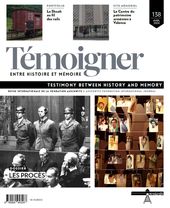
This dossier will deal with trials that have provided a legal answer to a demand for justice. Several cases will be addressed ranging from Istanbul and the Nuremberg Doctors' trial to the German policemen of the Brussels Jewish section and the gacaca trials in Rwanda.
Table of contents (Dutch version)
Table of contents (French version)No. 137 (10/2023) Children's Literature in Light of the Holocaust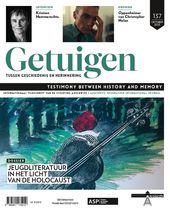
In France and Belgium, research into the relationship between children's literature and the Holocaust is rare, in contrast to the phenomenal attention in America (everyone knows Art Spiegelman's Maus) and in other English-speaking countries. Yet children's books depicting the Holocaust in words and pictures have been steadily gaining ground in post-war France and Belgium. While literary criticism and research still seem to be in their infancy, this dossier will show that critical analysis of this corpus is highly relevant for the future.
Table of contents (Dutch version)
Table of contents (French version)No. 136 (04/2023) The Executioners
The executioner has always fascinated and frightened. The perpetrators of mass crimes are those who carry out, facilitate or order the annihilation of a specific group. Issue 100 of Testimony: Between History and Memory, published in September 2008, examined the Nazi executioners. This dossier offers readers a historical and criminological approach to other genocides of the 20th century.
Table of contents (Dutch version)
Table of contents (French version)No. 135 (10/2022) Disobedience
This issue looks at the concept of disobedience in wartime. While the concept of civil disobedience may seem familiar in these times of endemic protest, there was a time when obedience was the rule. In a military context, disobedience was frequently followed by deadly consequences. This dossier focuses on three cases from the First World War and one from the Algerian War (1954-1962).
Table of contents (Dutch version)
Table of contents (French version)No. 134 (04/2022) The Killing of the ‘Useless’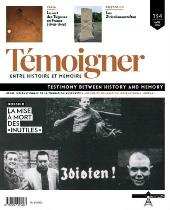
During the Second World War, the Nazi regime didn't just try to destroy the Jewish "race", which it considered dangerous. Before implementing the Final Solution, the Nazis massacred those who didn't fit in with their eugenic racial ideology and whom they considered inferior. In this dossier, we focus on the mentally and physically handicapped, systematic victims of Nazi pseudo-medical madness throughout the world conflict.
Table of contents (Dutch version)
Table of contents (French version)No. 133 (10/2021) 1918-1938: The politicisation of music in Europe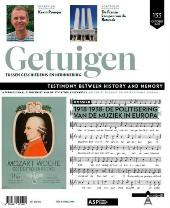
1918-1938: The politicisation of music in Europe
This dossier looks at the instrumentalisation of music by the political world between the wars. The cases are numerous and shed light on the way in which political propaganda was propagated in European musical culture.
Table of contents (Dutch version)
Table of contents (French version)No. 132 (04/2021) AKTION REINHARDT and AKTION ERNTEFEST
AKTION REINHARDT and AKTION ERNTEFEST
The Aktion Reinhardt saw approximately 1.8 million Polish Jews perish in the gas chambers of Bełżec, Sobibór, Treblinka and Majdanek between March 1942 and November 1943. The Jews who ‘escaped’ the gas chambers were shot in Majdanek, Trawniki and Poniatowa on 3 and 4 November 1943 during Aktion Erntefest. The dossier we are proposing takes stock of current research on the Aktion Reinhardt. This historical event has experienced a resurgence of interest among historians of the Shoah over the last fifteen years, thanks, among other things, to archaeological advances at the various sites concerned. We have come a long way since Yithzak Arad's pioneering work in 1987: Belzec, Sobibor, Treblinka: the Operation Reinhard Death Camps. The dossier highlights different perspectives to discuss current research related to the issue. It addresses the erasure of traces, the sociological perspectives of the executioners, the excavation of extermination sites and the most recent historiography.
Table of contents and abstracts (Dutch version)
Table of contents and abstracts (French version)No. 131 (10/2020) Historiography of the Second World War in the Far East
Historiography of the Second World War in the Far East
For many people, 8 May 1945 and the surrender of Nazi Germany is the final chapter of the Second World War. However, it is often forgotten that the months between May and September 1945 were decisive for the future of the world, as fierce fighting continued in the Pacific between the United States and the Japanese Empire until the latter’s unconditional surrender on 2 September 1945, the actual date of the end of the Second World War.Table of contents and abstracts (Dutch version)
Table of contents and abstracts (French version)No. 130 (04/2020) Reception of the Shoah and mentalities in Jewish and Christian circles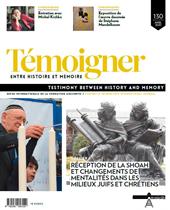
Reception of the Shoah and mentalities in Jewish and Christian circles
The reception of the Shoah has become, for all of humanity, a place of questioning and awareness. This dossier will aim to establish and evaluate the modalities and challenges of the transmission of the Shoah and to measure the resulting changes in identities and mentalities. What were the Catholic views on Judaism before and during the Shoah? What Jewish liturgies and interreligious rites exist for the commemoration of the Shoah in Israel and the United States? The evolution of mentalities in the Jewish world in relation to the Shoah will also be exposed through the analysis of the so-called Bitburg controversy, triggered by the visit of the American President, Ronald Reagan, to the German military cemetery of Bitburg (FRG) in May 1985. The Auschwitz Carmel affair (1985-1993) finally reveals the involvement of the Belgian and French Churches in the resolution of the conflict and is undoubtedly a key stage in the Church's 'teaching of esteem' with regard to the Jews. The historical answers provided in this dossier to the question of the Shoah may be decisive for the survival of Judaism and the relationship between Judaism and Christianity.
Table of contents and abstracts (Dutch version)
Table of contents and abstracts (French version)No. 129 (10/2019) Recognition of victims
Recognition of victims
In recent decades, the idea has gained ground that victims of mass crimes deserve recognition. This has become an essential category of our memorial culture. This dossier aims to take stock of this issue by looking at the broad spectrum of measures to ensure recognition, from simple remembrance to targeted judicial interventions, and by recalling the growing importance of the victim in international criminal justice. It returns to the problematic aspects of recognition when it leads to competition among victims.
Table of contents and abstracts (Dutch version)
Table of contents and abstracts (French version)No. 128 (04/2019) 25 years on, how to remember the Tutsi genocide
Kwibuka [Remember]. 25 years on, how to remember the Tutsi genocide
April 1994. Images of mutilated bodies are projected on European screens, originating from Rwanda. 25 years later, we remember.Table of contents and abstracts (Dutch version)
Table of contents and abstracts (French version)No. 127 (10/2018) Perpetuation of violence after 1918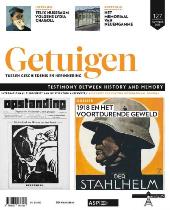
Perpetuation of violence after 1918
One hundred years ago, the First World War ended in November 1918. After four years of bloodshed, peace returns to Europe. At least, that was the impression of the victors at the time, and today it is also the impression of the commemorators who celebrate its centenary. The historical reality is more complex. At least until 1923, violence continued in the form of revolutions and counter-revolutions, wars and civil wars. The spirits also remain in the grip of violence on both the left and the right. The dossier proposes to define the contours of this Europe so strongly marked by the Great War, by evoking the culture of violence established by it and which, finally, degenerated into the total explosion of the Second World War.
No. 126 (04/2018) Questions about the future of remembrance work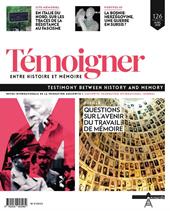
Questions about the future of remembrance work
On 20 and 21 January 2017, the seminar ‘Questions on the future of remembrance work’ was held in Esch-sur-Alzette, Grand Duchy of Luxembourg. The five articles in this dossier taken from the conference proceedings attempt to answer the following questions: How can we build a critical memory of the Shoah, free of myths and national fragmentation? How do we anticipate the absence of direct witnesses? In the future, who transmits what, and how?
No. 125 (10/2017) Persecution of homosexuals by the Nazis
Persecution of homosexuals by the Nazis
Historical knowledge of the Nazi persecution of homosexuals and their deportation has made significant progress in recent years due to the increase in research on the subject. In this dossier, recognised researchers as well as young doctoral and PhD students take the floor. The insights they provide concern both the question of the singular destiny of homosexual men and women during the Second World War and the way in which the memory of the homosexual victims of Nazism has evolved since the end of that war.
No. 124 (04/2017) Music in the camps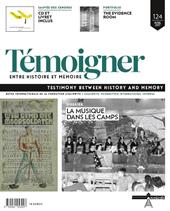
Music in the camps
Music was an integral part of the concentration camp world, Nazi and otherwise. What kind of music was composed and performed, and what exactly was its role in the camps? A factor of survival and resistance for the prisoners, a way for them to express their hope and their humanity - or, on the contrary, an instrument of oppression exploited by the executioners? What is the function of music in the work of memory following the experience of extreme violence and suffering? This dossier proposes to explore these issues.
No. 123 (10/2016) Translating Memory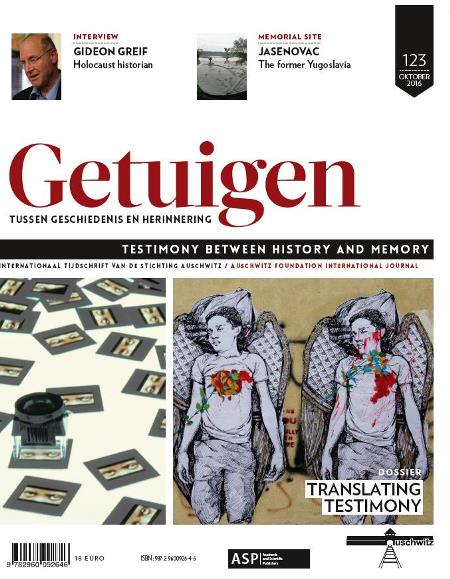
Translating Memory
Presentation of the dossier: What is the relationship between testimony, defined as a more or less ritualized firstperson account of political violence, and translation? Correspondingly, how does the translator position herself towards the witness? Can the translator be, or become, a witness? How, when and why are testimonies translated? Which linguistic and discursive strategies do translators resort to when faced with ethically challenging texts? Which role do they play exactly in the transmission of the historical knowledge, cultural values or social critique conveyed by the testimony? Does translation weaken or rather reinforce the relevance and impact of the original statement? How important is translation in literary, political and institutional settings? Do these specific settings determine translation practice in significant ways? To which extent can subsequent processes of transcription, editing, translation and archiving affect the source text? And how accurate are the boundaries we draw to distinguish witnessing from translating, documentary from literary testimony, the original from its translation? These are the main questions we intend to explore in our dossier.
No. 122 (04/2016) Revisionism and negationism
Revisionism and negationism
Strictly speaking, Holocaust denial is the ‘doctrine denying the reality of the Nazi genocide of the Jews, including the existence of the gas chambers’; by extension, the term refers to the denial of other genocides and crimes against humanity. The literature on Holocaust denial is extensive. There are studies on the subject in many countries as well as biographies of deniers. The argumentative and rhetorical strategies of the deniers have been widely deciphered. Websites systematically dismantle their fallacies. While there is no shortage of reliable information on the phenomenon, it is essential to return to it again and again, for several reasons.
No. 121 (10/2015) Extreme violence on stage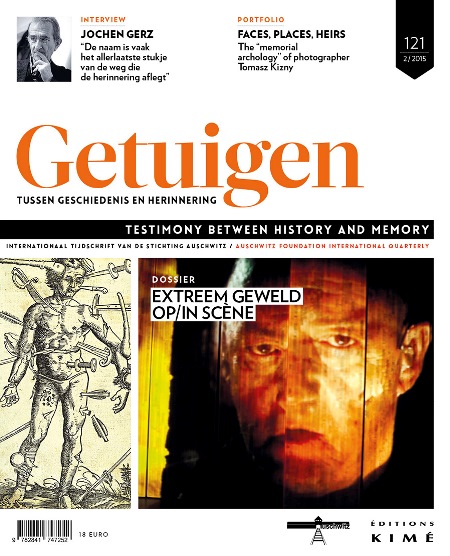
Extreme violence on stage
Extreme violence shows itself. It bursts through the screens. It surfs from one style and medium to another: news reports, documentaries, fiction, arts of all kinds. Yet theatre distinguishes itself from this mêlée all while constantly returning to the subject. Differently. Linked from its origins to the representation of cruelty and having “miraculously” escaped the often sterile polemics on the interdiction (or not)... of representing the Holocaust, it is still with the same youthfulness that theatre deals with extreme violence today, relentlessly pursuing the articulation of ethics and aesthetics.
No. 120 (04/2015) What future is there for the memory of the Armenian genocide?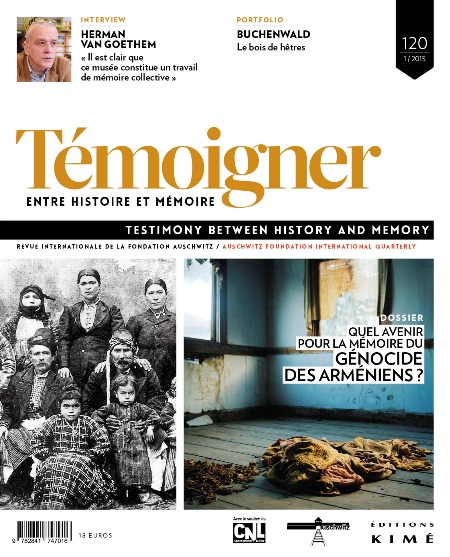
What future is there for the memory of the Armenian genocide?
The 1915 genocide of Turkish Armenians still stirs up numerous debates, controversies, declarations of principle, statements and counter-statements, and even negation. However, as we speak, ties are being established more and more openly, bridges are built and bonds strengthened between the Armenian and Turkish communities. Is reconciliation possible?
No. 119 (12/2014) 70 years ago, Auschwitz. Looking back on Primo Levi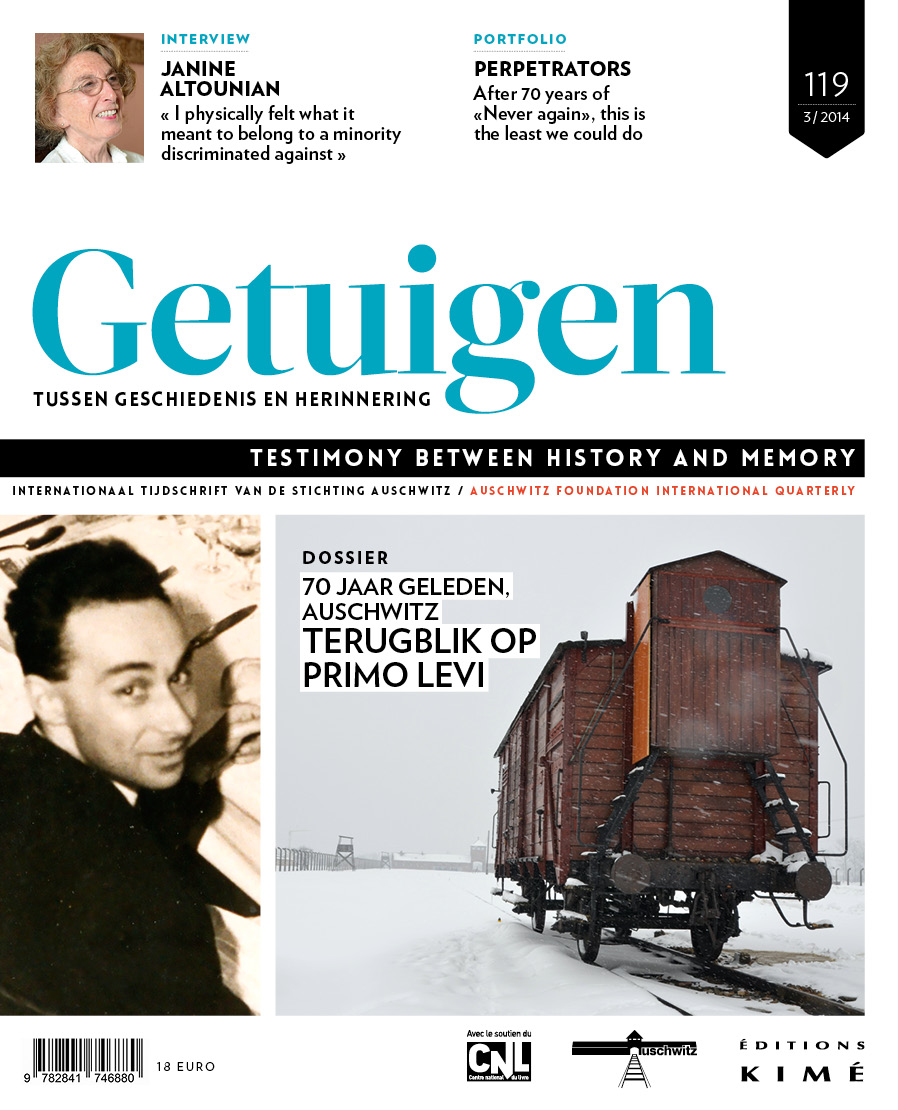
70 years ago, Auschwitz. Looking back on Primo Levi
27 January 1945. Seventy years ago the first soldiers of the Red Army marched into Auschwitz. One might argue that the camp was “liberated” then, but the truth is that neither Auschwitz, nor any of the other Nazi camps, was ever a priority to the Allied Powers. Primo Levi was one of the few survivors who knew how to hide and escape the enforced evacuation of the camps. With this dossier, we want to cast light on the complex figure that Levi was: a Jew, a deportee, a chemists, a witness, and a writer. It sets out to study his oeuvre and his interpretation of the notions of “resistance” and “engagement”, in order to understand how he eventually became a “professional survivor”, as he once described himself.
No. 118 (09/2014) Dictatorship and terror in Argentina, Chile and Uruguay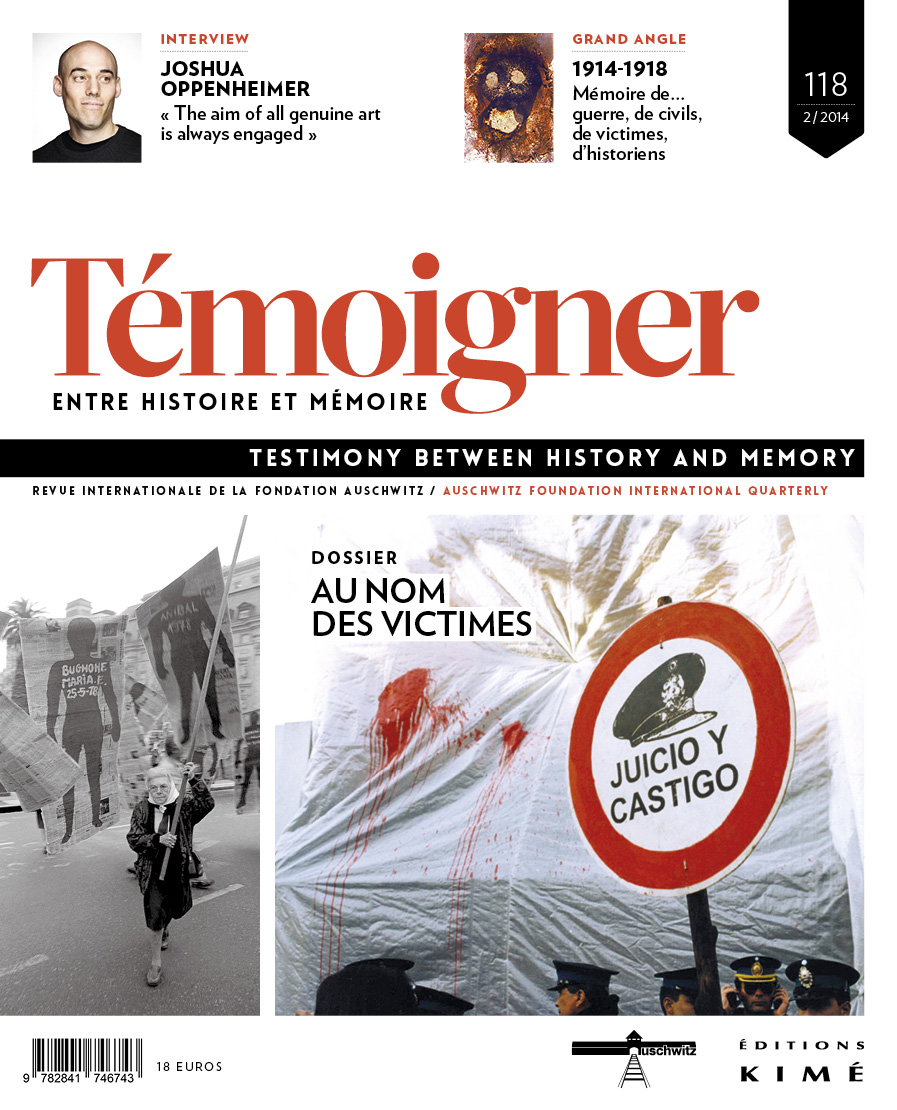
In the name of the victims. Dictatorship and State terror in Argentina, Chile and Uruguay
During the 1970s and 1980s, Argentina, Chile and Uruguay were in the grip of military dictatorships. The process of democratic transition that followed the long period of state terror involved the construction of particular narratives and memories, leading to a reconfiguration of the past. Despite local differences, this process is very much centered at the figure of the victim – a figure the articles in this dossier, collected by Claudia Feld, Luciana Messina and Nadia Tahir, set out to explore.
No. 117 (03/2014) Friends? Enemies? Relationships between memoriesAmis ? Ennemis ? Relations entre mémoires / Vriend of vijand? Hoe herinneringen zich tot elkaar verhouden [Friends? Enemies? Relationships between memories]
Much has been said and written about group memories, limiting their mutual relationships and history to conflicts, “wars”, competitions, or strategies for eclipsing or silencing. These terms have now become the platitudes of a kind of more general doxa about collective and cultural remembrance. This dossier proposes a critical reading of those terms and of that doxa by questioning the emergence, constitution, and inter-relating of different exemplary memories of the major violent episodes of the 20th century. It will address the relationships that those memories can maintain with other memories with which they share, if not the same event, at least similar characteristics and concerns.
No. 116 (09/2013) Memory tripsVoyages mémoriels / Herdenkingsreizen [Memory trips]
Should we fear what has been grouped under the term “memorial tourism”? Or should we take this as a reality of our time? Can any visitor, group or individual, nowadays be absorbed in the category of “tourist”? Or is this category a remote intellectual reduction of a personal experience that everyone is aiming during his visit? The problem appears in a somewhat different light when we think of tours for young people supervised by adults, usually teachers. This dossier gives the floor to historians and teachers with experience in the field.
No. 115 (03/2013) Memory construction in SpainL’Espagne en construction mémorielle / Spanje en de opbouw van de gedachtenis [Memory construction in Spain]
This dossier’s objective is to provide a benchmark for understanding the plural identities and relationships between memories and representation forms in contemporary Spain. Indeed, it is necessary today to take a fresh look not only on the stratified memories of the civil war, exile and the Franco repression, but also on the reception of other memories such as that of the Holocaust, and to propose new readings. We propose to highlight the conflicting or fruitful tensions between official actions, initiatives of associations and of artistic events.
No. 114 (12/2012) Memorial SitesSites mémoriels / Gedenkplaatsen [Memorial Sites]
Memorial sites constitute the concrete trace of European remembrance and history of the twentieth century. But what do they look like today? Exhibition and conservation criteria have changed during the last ten to fifteen years, like advances in historical research have changed the way we read and reconstruct past events. This is not only due to the fact that we have moved from a past history written by witnesses to a history written by professional historians. A new consciousness has emerged concerning transmission methods (memory education), and archeology has strengthened historical research. We tore off the veil of ideology that often influenced and prescribed the way we imagined permanent exhibitions, conservation and visits. Can we say we have entered a new era in memory transmission? It remains, in many ways, an open bet on the present and the future.
No. 113 (09/2012) The Taboos of German HistoryLes tabous de l'histoire allemande / De taboes van de Duitse geschiedenis The Taboos of German History]
The most painful or ambiguous periods in twentieth-century German history are characterized by numerous taboos, expressed in literature, photography and film as so many “returns of the repressed”. These studies focus in part on problems of antisemitism, and thus on the relationship of German-speaking societies to the Shoah. They also examine the way in which those societies confronted the violence they suffered, such as bombing, fleeing from the Red Army and the expulsions, and mass rapes.
No. 112 (06/2012) Children of the Spanish Civil WarLes enfants de la Guerre d'Espagne. Expériences et représentations culturelles / De kinderen van de Spaanse Burgeroorlog. Ervaringen en culturele voorstellingen [Children of the Spanish Civil War: Experiences and Cultural Representations]
The dossier in this issue deals with the experiences and cultural representations of childhood during the Spanish Civil War. It aims to help towards a better understanding of that conflict, which tore apart a population living on the same territory, by confronting the experiences of Spanish children who lived through it – as expressed in various forms during or after the war – with representations of those same children, particularly those coming from adults.
No. 111 (12/ 2011) Dangerous Game between Art and PropagandaArt & propagande : jeux inter-dits / Gevaarlijk spel tussen kunst en propaganda [Dangerous Game between Art and Propaganda]
Since the media came into existence, political institutions from political parties to governments have used them to promote their image, in order to win the support of the public they addressed. Authoritarian powers use the media as a means of consolidating their domination. But how can artists take part in propaganda, whose purposes are the opposite of those generally attributed to art? Does that mean setting aside their vocation, or do they themselves distort that vocation?
No. 110 (10/2011) Displacements, Deportations, ExileDéplacements, déportations, exils / Volksverhuizingen, deportaties, verbanningen [Displacements, Deportations, Exile]
States and criminal groups exploit population displacements to isolate or get rid of certain populations. In addition to being denied their normal rights, these populations lose visibility and are deprived of their reference points and social frameworks. In this way it is possible to make them the victims of constraints (deterritorialization, forced labor…) or violence (famine, massacres genocide…). These developments have spread on an unprecedented scale since the First World War and continue to grow worldwide. But there is also a dimension of remembrance to this reality: memories of these displacements are now being expressed in literature, and in exhibitions and museums. This dossier examines the contemporary double aspect of history and memory.
No. 109 (03/ 2011) 20th Century Wars and Genocides in Graphic Novels and Comic StripsLa bande dessinée dans l'orbe des guerres et des génocides du XXe siècle / Twintigste-eeuwse oorlogen en genociden in het stripverhaal [Twentieth Century Wars and Genocides as Portrayed in Graphic Novels and Comic Strips]
No. 108 (09/2010) How Documentaries Handle HistoryLe traitement de l'histoire dans les documentaires filmiques / De behandeling van de geschiedenis in de documentaire film [How Documentaries Handle History]
No. 104 (09/2009) Anti-fascism Revisited: History, Ideology, RemembranceL'Antifascisme revisité. Histoire – Idéologie – Mémoire / Nogmaals antifascisme. Geschiedenis, ideologie, gedachtenis [Anti-fascism Revisited: History, Ideology, Remembrance]
No. 103 (06/ 2009) Nazi Crimes and Genocides on the ScreenCrimes et génocides nazis à l'écran / Nazimisdaden en genociden op het scherm [Nazi Crimes and Genocides on the Screen]
No. 102 (03/ 2009) The Portrayal of Political Criminals in Films, Plays, Literature...Criminels politiques en représentation. Arts, cinéma, théâtre, littérature, médias / De representatie van politieke misdadigers. Kunst, film, theater, literatuur, media [The Portrayal of Political Criminals in Films and Plays, in Literature and in the Media]
No. 101 (12/2008) How to Educate, How to Remember?Quelle pédagogie, pour quelle(s) mémoire(s) ? / Welke pedagogie, voor welke herinnering(en)? [How to Educate, How to Remember?]
No. 100 (09/2008) Questions about the “Executioners”Questions de « bourreaux » / De kwestie van de “beul” [Questions about the “Executioners”]
Contact
Auschwitz Foundation – Remembrance of Auschwitz
Rue aux Laines 17 box 50 – B-1000 Brussels +32 (0)2 512 79 98
+32 (0)2 512 79 98 info@auschwitz.be
info@auschwitz.be
BCE/KBO Auschwitz Foundation: 0876787354
BCE/KBO Remembrance of Auschwitz: 0420667323
Office open from Monday to Friday 9:30am to 4:30pm.
Visit only by appointment.![]()
![]()
![]()
![]()
Become a member
To become a member of Remembrance of Auschwitz ASBL, take part in its activities and support its actions, please contact us.
Membership costs €40.00, payable to account n° 310-0780517-44 (IBAN : BE55 3100 7805 1744 – BIC : BBRUBEBB)
Donations of more than €40.00 qualify for a tax exemption for Belgian tax-payers.








































